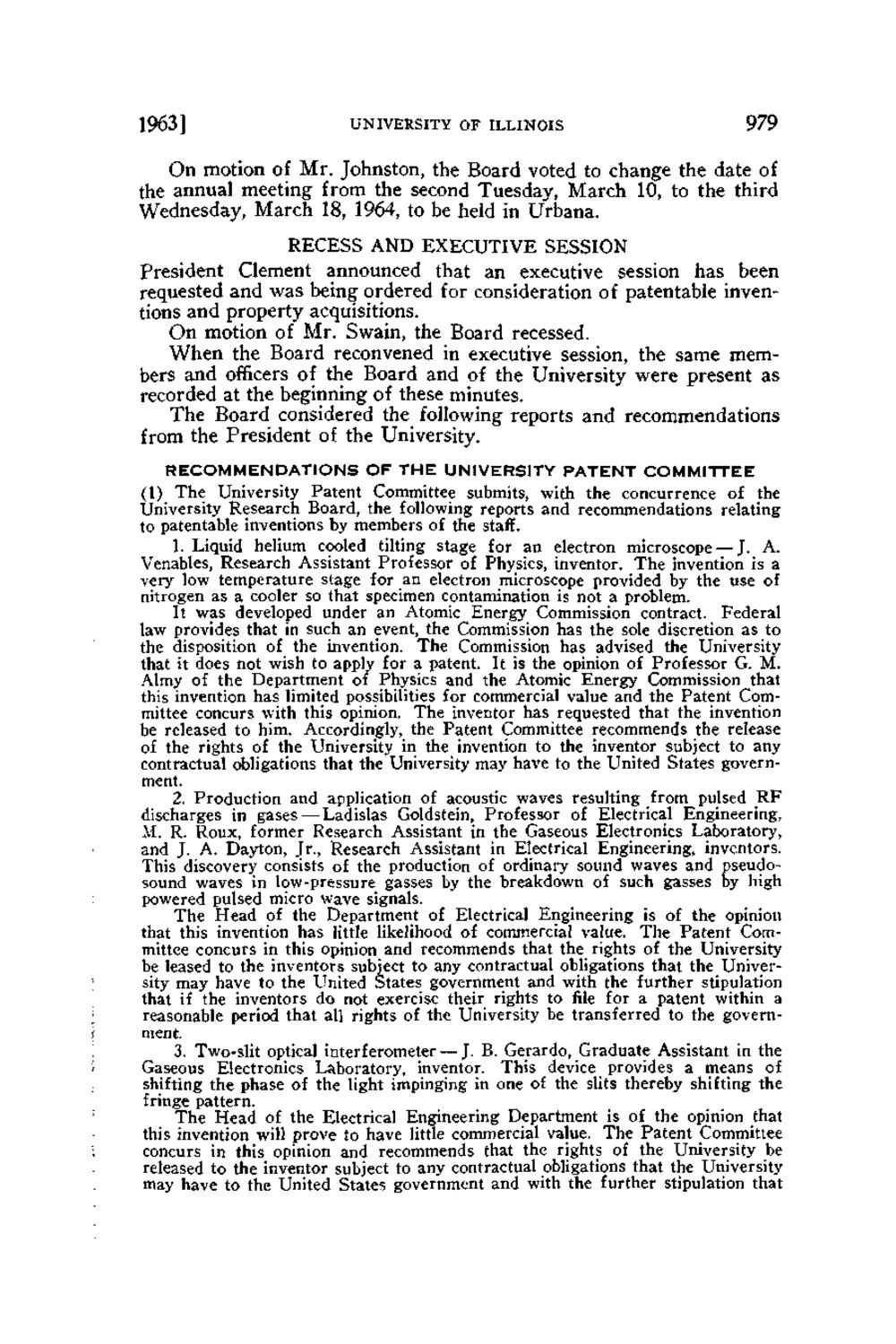| |
| |
Caption: Board of Trustees Minutes - 1964
This is a reduced-resolution page image for fast online browsing.

EXTRACTED TEXT FROM PAGE:
1963] UNIVERSITY OF I L L I N O I S 979 On motion of Mr. Johnston, the Board voted to change the date of the annual meeting from the second Tuesday, March 10, to the third Wednesday, March 18, 1964, to be held in Urbana. RECESS AND EXECUTIVE SESSION President Clement announced that an executive session has been requested and was being ordered for consideration of patentable inventions and property acquisitions. On motion of Mr. Swain, the Board recessed. When the Board reconvened in executive session, the same members and officers of the Board and of the University were present as recorded at the beginning of these minutes. The Board considered the following reports and recommendations from the President of the University. RECOMMENDATIONS OF THE UNIVERSITY PATENT COMMITTEE (1) The University Patent Committee submits, with the concurrence of the University Research Board, the following reports and recommendations relating to patentable inventions by members of the staff. 1. Liquid helium cooled tilting stage for an electron microscope — J . A. Venables, Research Assistant Professor of Physics, inventor. T h e invention is a very low temperature stage for an electron microscope provided by the use of nitrogen as a cooler so that specimen contamination is not a problem. It was developed under an Atomic Energy Commission contract. Federal law provides that in such an event, the Commission has the sole discretion as to the disposition of the invention. The Commission has advised the University that it does not wish to apply for a patent. It is the opinion of Professor G. M. Almy of the Department of Physics and the Atomic Energy Commission that this invention has limited possibilities for commercial value and the Patent Committee concurs with this opinion. The inventor has requested that the invention be released to him. Accordingly, the Patent Committee recommends the release of the rights of the University in the invention to the inventor subject to any contractual obligations that the University may have to the United States government. 2. Production and application of acoustic waves resulting from pulsed R F discharges in gases — Ladislas Goldstein, Professor of Electrical Engineering, M. R. Roux, former Research Assistant in the Gaseous Electronics Laboratory, and J. A. Dayton, Jr., Research Assistant in Electrical Engineering, inventors. This discovery consists of the production of ordinary sound waves and pseudosound waves in low-pressure gasses by the breakdown of such gasses by high powered pulsed micro wave signals. T h e Head of the Department of Electrical Engineering is of the opinion that this invention has little likelihood of commercial value. The Patent Committee concurs in this opinion and recommends that the rights of the University be leased to the inventors subject to any contractual obligations that the University may have to the United States government and with the further stipulation that if the inventors do not exercise their rights to file for a patent within a reasonable period that all rights of the University be transferred to the government. 3. Two-slit optical interferometer—• J. B. Gerardo, Graduate Assistant in the Gaseous Electronics Laboratory, inventor. This device provides a means of shifting the phase of the light impinging in one of the slits thereby shifting the fringe pattern. T h e Head of the Electrical Engineering Department is of the opinion that this invention will prove to have little commercial value. The Patent Committee concurs in this opinion and recommends that the rights of the University be released to the inventor subject to any contractual obligations that the University may have to the United States government and with the further stipulation that
| |